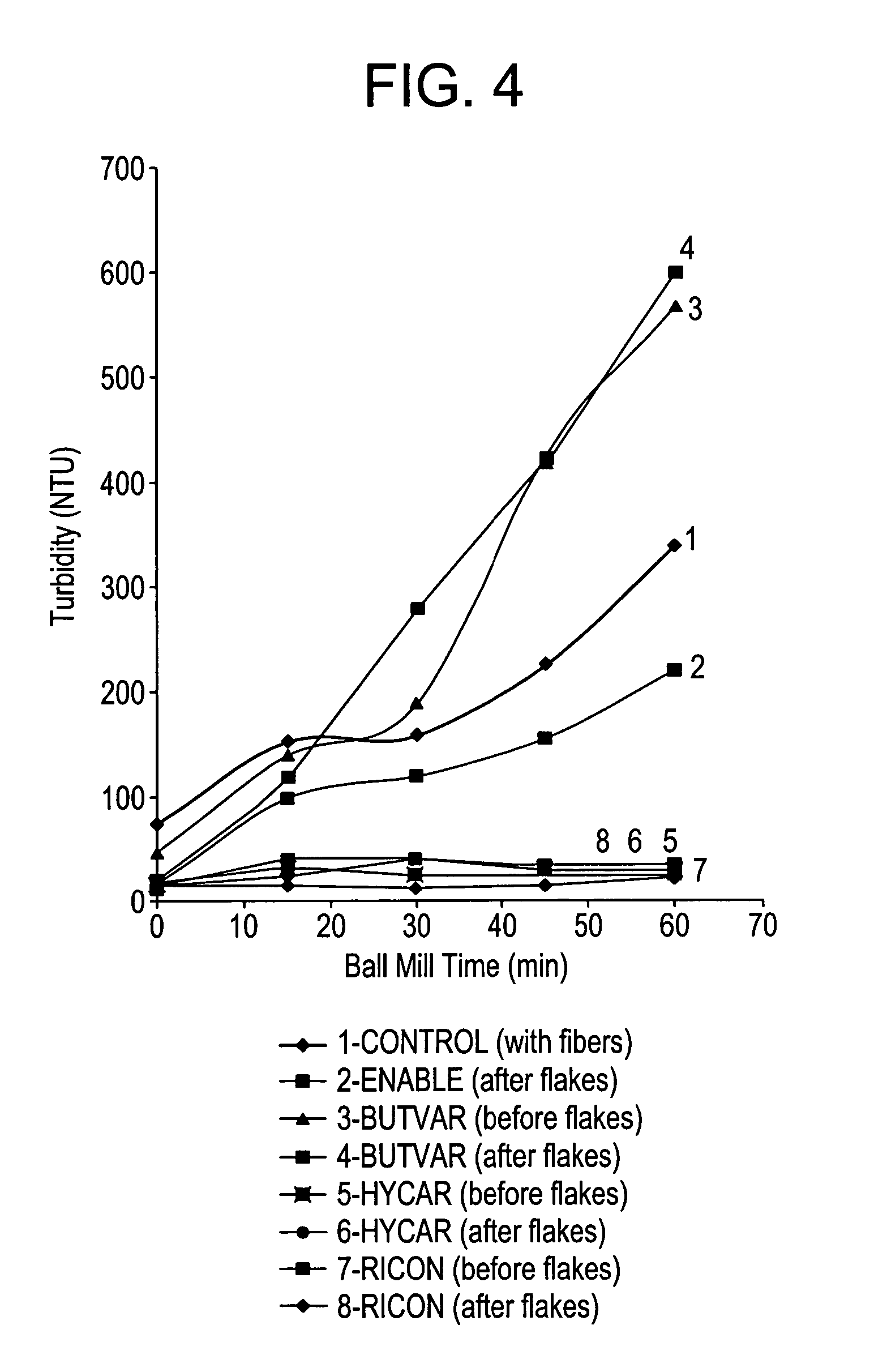Particulate material containing thermoplastics and methods for making and using the same
a technology of thermoplastics and particulate materials, applied in the field of particulate materials, can solve the problems of a large risk of precipitating a borehole wall collapse, methods with several-technical and cost limitations, and achieve the effect of reducing water pickup
- Summary
- Abstract
- Description
- Claims
- Application Information
AI Technical Summary
Benefits of technology
Problems solved by technology
Method used
Image
Examples
example 1
[0318]This example was undertaken to demonstrate the synthesis and properties of resin coated bauxite and resin coated sand. In the Examples the silane is A1100 adhesion promoter from OSI Corporation. The proppant was coated with PFFA Resole Ex18663 known as Plasti Flake EX18663, a commercial phenol-formaldehyde resole furfuryl alcohol terpolymer resin manufactured by Borden, Inc. / North American Resins, Louisville, Ky.
[0319]Also, the proppant was coated with a layer of PF Novolac 5150 known as Plasti Flake EX5150, a commercial phenol-formaldehyde novolac manufactured by Borden, Inc. / North American Resins, Louisville, Ky.
[0320]Chembetaine is a shortened reference to a lubricant. It is a fatty acid amide derivative (coamidopropyl hydroxysultaine) purchased from Chemron Corp.
[0321]Ammonium chloride is listed in % Conc. / gms of ammonium chloride in aqueous solution. KYNOL novoloid fibers are available from American Kynol, Inc., Pleasantville, N.Y.
[0322]ESCOR AT325: is an acid (EMAAA) ter...
example 2
[0351]This experiment was undertaken to demonstrate the use of sand triple coated with a resin that contains modifiers. The turbidity results of all the modifiers used in sand that has three curable coatings (made according to TABLE 2) are shown in TABLE 5. The first (innermost) coating comprises FA resole that is a terpolymer of phenol, formaldehyde and furfuryl alcohol alcohol with an ammonium chloride catalyst. The second (middle) layer also comprises FA resole that is a terpolymer of phenol, formaldehyde and furfuryl alcohol alcohol with an ammonium chloride catalyst. The third (outer) layer comprises novolac and HEXA and is at least partially curable). The lower the turbidity the lower the tendency to fracture and produce dust. The modifiers were added either before or after flakes. In all cases, the coated materials before the ball mill test were almost dust-free. On milling, the dust level increases. Irrespective of when the modifier was added, both HYCAR and RICON modifiers ...
example 3
[0354]This example employs a proppant, which has a substrate of nearly pure bauxite having a specific gravity of about 3.4 to 3.6 and three curable coatings. The first (innermost) coating comprises FA resole that is a terpolymer of phenol, formaldehyde and furfuryl alcohol alcohol with an ammonium chloride catalyst. The second (middle) layer also comprises FA resole that is a terpolymer of phenol, formaldehyde and furfuryl alcohol alcohol with an ammonium chloride catalyst. The third (outer) layer comprises novolac and HEXA and is at least partially curable and modified with HYCAR and RICON modifiers. FIG. 5 shows results from tests of modified sample having 1%, 1.75% and 2.5% HYCAR 1330X33 (based on weight of resin on the substrate). FIG. 5 shows the 2.5% HYCAR modified sample is the best of all. However, this 2.5% seems to be wet and the wettability is poor. On the other hand, wettability of the 1% HYCAR modified sample was as good as that of the unmodified CONTROL sample.
[0355]FI...
PUM
| Property | Measurement | Unit |
|---|---|---|
| weight percent | aaaaa | aaaaa |
| temperatures | aaaaa | aaaaa |
| grain size | aaaaa | aaaaa |
Abstract
Description
Claims
Application Information
 Login to View More
Login to View More - R&D
- Intellectual Property
- Life Sciences
- Materials
- Tech Scout
- Unparalleled Data Quality
- Higher Quality Content
- 60% Fewer Hallucinations
Browse by: Latest US Patents, China's latest patents, Technical Efficacy Thesaurus, Application Domain, Technology Topic, Popular Technical Reports.
© 2025 PatSnap. All rights reserved.Legal|Privacy policy|Modern Slavery Act Transparency Statement|Sitemap|About US| Contact US: help@patsnap.com



